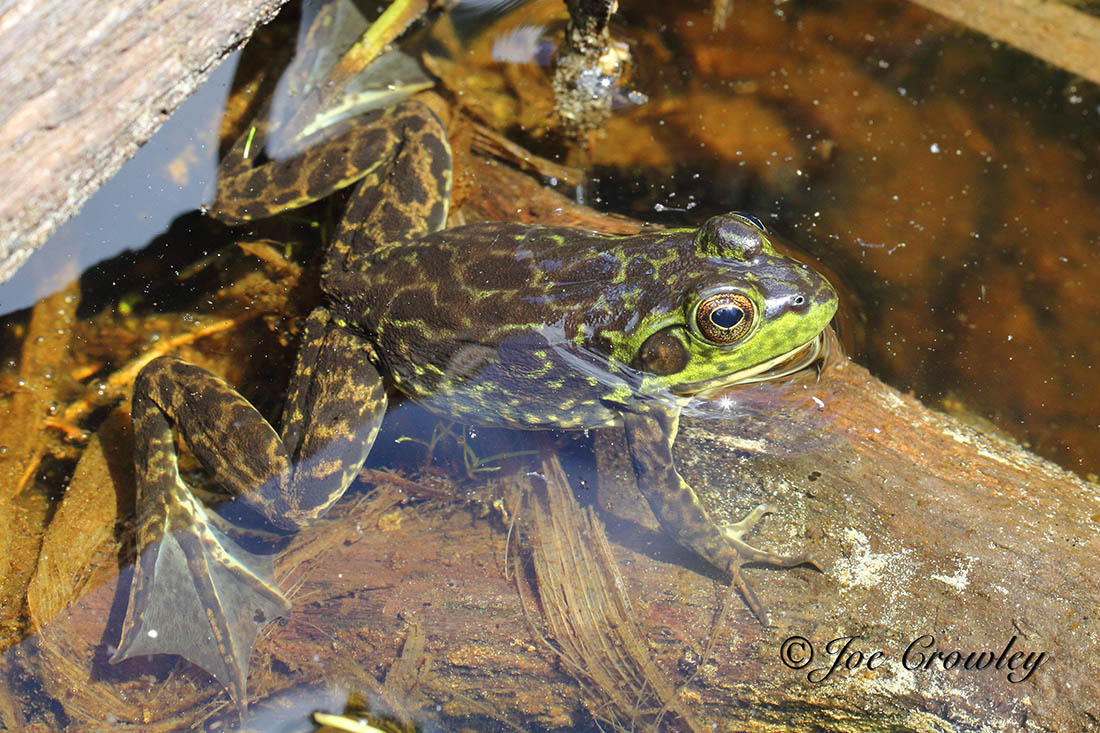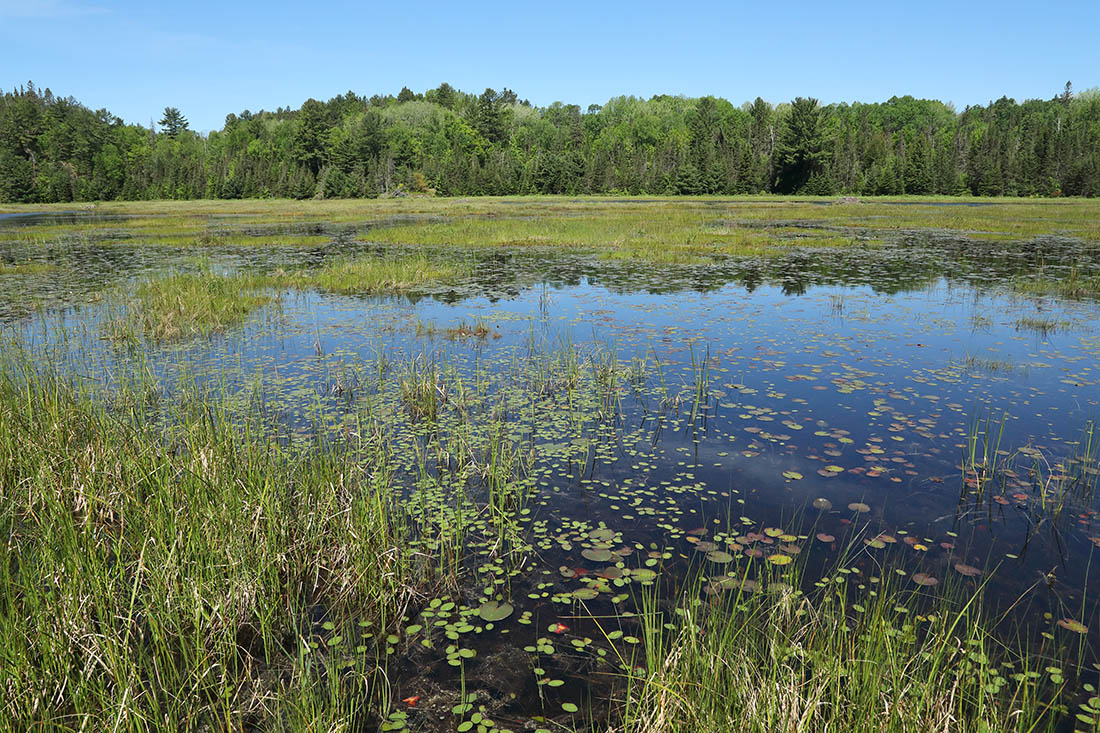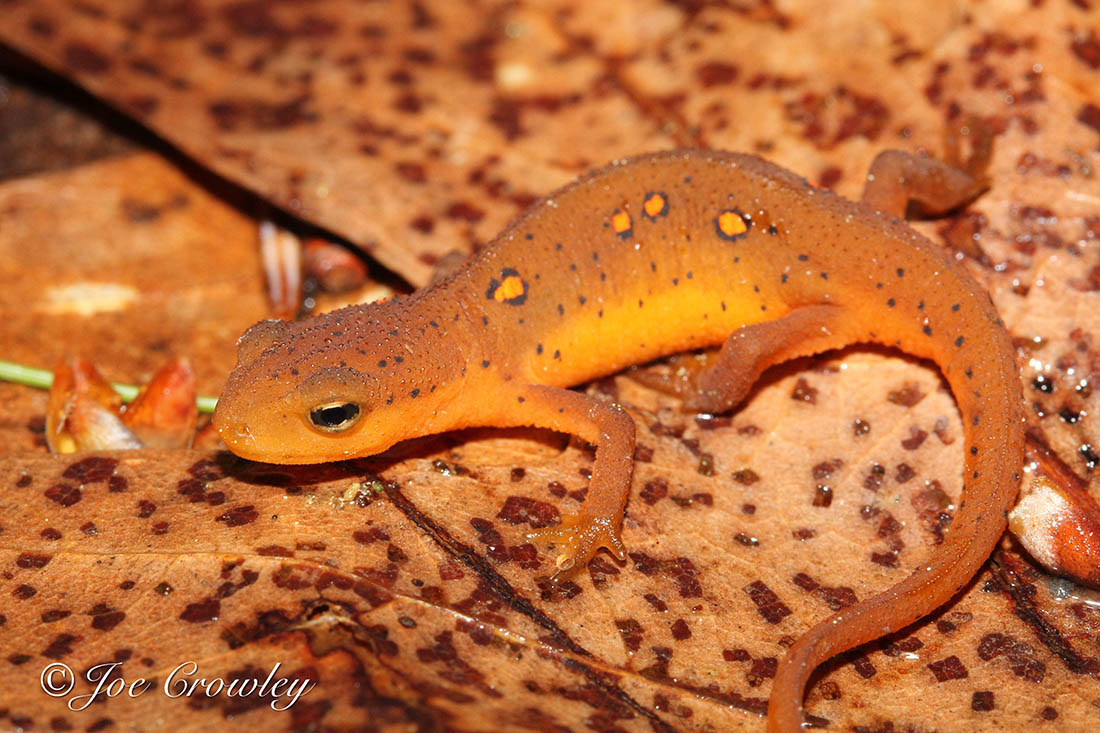The mink frog (Lithobates septentrionalis) is a medium-sized frog native to eastern North America. It has a large distribution in eastern Canada that extends from southwestern Manitoba east to Nova Scotia and north around James Bay and into southern Labrador. Mink frogs are highly aquatic and are typically found in large, permanent water bodies.

Description
Mink frogs can reach a body length of 7.6 cm, although most individuals are smaller than that. Females reach larger sizes than males. Mink frogs are brownish, olive or green with large, blackish-brown blotches, or mottling. Individuals have varying amounts of reticulating greenish-yellow lines, and some individuals are very dark, with prominent reticulation. The upper lip is usually yellow to light green. The belly is white, and some individuals may have pale yellow on the chin, throat and lower sides. Dorsolateral folds (ridges of raised skin that extend down the back) may be present but are often faint, incomplete or absent. The hind feet have extensive webbing that extends to the last joint of the fourth (longest) toe and the tips of the other toes.
Mink frog eggs are brown to black on top and creamy yellow on the bottom. They are surrounded by two jelly envelopes. Larvae, also known as tadpoles, are brown, tan, olive or green, with dark blotches and mottling. The belly is opaque straw yellow. Mink frog tadpoles can grow up to 10 cm in length before undergoing metamorphosis (transforming from a tadpole into a juvenile frog).
Distribution and Habitat
Mink frogs are widely distributed throughout eastern Canada. They are found in southwestern Manitoba, Ontario, Quebec, New Brunswick, Nova Scotia and southern Labrador. Populations have been documented in Newfoundland, but these are believed to have been introduced to the province. Mink frogs have a relatively small distribution in the United States, extending from northern Maine to upper New York State and from the Michigan peninsula to northeastern Minnesota.
Mink frogs live and breed in permanent, cold-water habitats such as large wetlands, beaver ponds, shallow bays of lakes and slow-flowing streams. They prefer shallow areas with abundant vegetation and soft, mucky bottoms. Mink frogs are highly aquatic and rarely venture far from water. Individuals spend the winter in the mud at the bottom of permanent water bodies.
Did you know?
The mink frog is a cold-adapted species that thrives in Canada’s cool climate. Unlike most other North American amphibians, the mink frog is found primarily in Canada, with only a small portion of its range extending south into the United States.
Reproduction and Development
In Canada, mink frogs typically breed from June to early August, although most breeding likely takes place in June and July. Males call to attract females. Their call is a rapid series of croaks, often followed by a series of “rumbles.” It is likened to the sound of a hammer rapidly tapping wood. The female typically lays between 500 and 2,000 eggs in a gelatinous mass attached to vegetation below the water’s surface. As with most frog species, the male fertilizes the eggs as they are laid. The eggs develop quickly and hatch into aquatic larvae (tadpoles) after about two weeks. Most tadpoles undergo metamorphosis after one year, although some individuals may spend two winters as tadpoles. Individuals reach maturity 1–2 years after metamorphosis. Mink frogs have a relatively short adult lifespan, estimated at no more than 5–6 years.
Did you know?
During the breeding season, calling males are aggressive toward each other and space themselves out throughout the habitat. If two males get too close (i.e. within about a metre), they will attack each other. These conflicts may involve chases, brief wrestling bouts, jump attacks and head-butting.
Diet and Predation
Adult and juvenile mink frogs are carnivorous and will eat any other species they can capture and swallow. Their diet includes a wide range of insects (e.g., beetles, dragonflies, flies), spiders, snails and slugs. They are sit-and-wait predators, meaning they remain still and wait for their prey to approach them. Tadpoles are herbivores and feed primarily on algae.
Juvenile and adult mink frogs have a variety of predators, including mammals (e.g., raccoons and skunks), snakes, birds and other frogs. Eastern newts are known to prey on mink frog eggs, while fish, aquatic insects and leeches eat the tadpoles. Mink frogs are well-camouflaged and can be difficult to see when floating amidst aquatic vegetation. They are wary of potential predators and are quick to retreat underwater at the first sign of danger. They also produce a pungent skin secretion, which likely helps deter predators. Its smell is described as being similar to that of rotting onions or a mink—hence the species’ name.

Status and Threats
Globally, the mink frog is listed as least concern by the International Union for the Conservation of Nature. This species is widespread and abundant in eastern Canada, and its status has not been assessed by the Committee on the Status of Endangered Wildlife in Canada (COSEWIC). Mink frogs nonetheless face a variety of threats, particularly in the southern part of their range, where human population densities are highest. These threats include habitat loss, pollution and the introduction or spread of pathogens such as ranavirus (viruses that can cause mass mortality in frogs). Their porous skin and aquatic life stages make amphibians particularly vulnerable to environmental pollutants such as pesticides, fertilizers, industrial chemicals and road salt. These chemicals have been documented to have a wide range of negative effects on frogs, including reducing growth and survival and causing developmental abnormalities.

 Share on Facebook
Share on Facebook Share on X
Share on X Share by Email
Share by Email Share on Google Classroom
Share on Google Classroom




